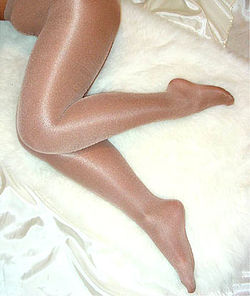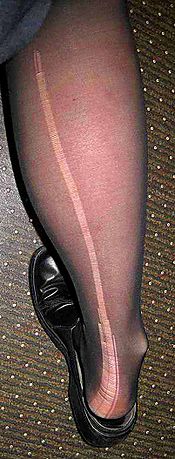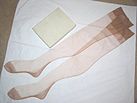Pantyhose

Pantyhose (also called tights) are sheer, close fitting coverings of the body from the waist to the feet, most frequently worn by women. Like stockings they are usually made of nylon. The one-piece pantyhose garment appeared in the 1960s and provided a convenient alternative to stockings (nylons).
The term 'pantyhose' originated in the United States, referring to the combination of 'panties' (an American term for women's underpants) with sheer nylon hosiery, meaning they are usually worn without other undergarments. In the United Kingdom, they are called tights, a term that refers to all such garments regardless of whether they are sheer lingerie or sturdy outerwear. In the U.S., the term tights is used for non-sheer garments typically made of a stretchy material like spandex, and worn during exercise or athletic activity, or as utility clothing.
History
In the 1920s the fashionable hemline for women's skirts and dresses began to rise enough to show a woman's legs and sheer hosiery that covered the legs was only available as stockings. They were typically made of silk or artificial silk (now known as rayon), and after 1939 with nylon.
In 1959, Allen Gant Sr. of Glen Raven Mills introduced pantyhose. Stocking manufacturers began using circular knitting machines to reduce manual labor and create seam-free stockings. In 1965, Glen Raven Mills introduced a seam-free version of pantyhose, which coincided with the introduction of the miniskirt. The miniskirt made it unfashionable to show the tops of a woman's stockings, and by the end of the decade pantyhose had replaced stockings almost entirely. This also contributed to a marked shift in foundation undergarment sales: younger women stopped buying girdles around this time. In the same period hosiery started adding spandex or elastane to give it stretch superior to crimping nylon. Glen Raven Mills still operates in North Carolina, U.S. as Glen Raven Inc.
Starting sometime in the 90s, pantyhose went almost completely out of fashion. Until recently, women, in general no longer wore pantyhose unless it was mandated by dress code, typically found at corporate companies and executive level. An exception to this was the wearing of special pantyhose such as fishnet or various pattern types, but this was a rather rare occurrence.
However, in the mid 00s of this century pantyhose have been appearing once again in fashion and public, indicating the reoccurring cycle of couture once again is bringing the leg covering back into vogue. With the return to Paris runways and Haute Couture it should only be a matter of time before pantyhose makes a mainstream resurgence.
Pantyhose styles
Pantyhose are available in a wide range of popular styles. The sheerness of the garment, expressed as a numerical 'denier'/'dtex', ranges from 3 (extremely rare, very thin, barely visible) to 15 (standard sheer) up to 30 (semi opaque) until 70 (opaque).
For people who want a slimmer form, they may opt to get "Control Top", which has a reinforced panty. The downside to Control Top Pantyhose are the panty lines that may appear when wearing high cut skirts or shorts. Sheer to Waist are just that - sheer from the toe to the waist. The "panty" portion is same thickness and color as the leg portion. Often, but not always, sheer to waist pantyhose will be reinforced along and on either side of the seam in the middle of the panty. Perfect for high slit gowns, mini-skirts and when wearing with lingerie.

Also for the person who wants a bit more support on the top half, there are pantyhose that have panel gussets incorporated into them. These are either single or double types. In the single type, there are two seams instead of the usual one, with a single one on the opposite side; with double panel gussets, there are two seams on either side. The single type can be worn either way. They both help to expand the top panty area. There are also types of pantyhose which have a lacy panty area which is normally floral in design.[citation needed] Many pantyhose brands now produce pantyhose that do away with seams completely, so that the outline is smooth from top to bottom.
The composition of pantyhose
Most pantyhose are composed of nylon and a mixture of spandex, which provides the elasticity and form fitting that is characteristic of modern pantyhose. Unfortunately, the nylon fabric is somewhat prone to tearing and it is common for very sheer hose to 'run' soon after snagging on something rough or sharp.
Pantyhose worn for fashion have a standard construction. The top of the waist is a strong elastic. The part covering the hips (panty area) is composed of a thicker material than the legs. The gusset or crotch is also a stronger material, sometimes made of cotton. The legs of the pantyhose are made of the thinnest material which has a consistent construction down to the toes, which may be reinforced to guard against wear.
Advantages of pantyhose
On mildly or moderately cold days, pantyhose help keep the legs warm for those wearing skirts or dresses. Above all pantyhose hides blemishes or scars on the legs, leg hair stubble, and varicose veins. On cold dry days, pantyhose can help prevent the legs from becoming too dry. Some companies regard wearing skirts or shorts without pantyhose as unprofessional and thus require people who wear skirts or shorts to work to also wear pantyhose or sheer tights.
Dark pantyhose, and black pantyhose in particular, can create the illusion of slimmer legs. Another flip side depends on the wearer's skin tone - dark hose shows runs when worn over light skin, whilst lighter hose show water spots flipped up from the heel after walking in the rain. Whilst, as detailed below, the material is not absorbent, it is quick drying (for example after walking in the rain/being splashed by traffic).
Support hosiery can be worn to support the leg. Regulating blood circulation in the legs, it helps those who work on their feet with preventing/helping varicose veins and resolving pain in the back and legs.

Disadvantages of pantyhose
The nylon fabric of pantyhose is extremely prone to runs (called laddering in the United Kingdom). A woman can even cause a run in the hose by catching the toenail of her big toe in the fabric when she puts the hose on, catching it on a desk, car, and numerous other 'risks'. Some women use clear nail polish to prevent runs from growing.
Unlike cotton, nylon is not an absorbent material. As a result, perspiration from the wearer's feet is more likely to remain in contact with the feet, which may feel unpleasant to the wearer. If one wears high heels with pantyhose, the increased moisture can cause the feet to slip forward in the shoe, causing the toes to be scrunched together. The increased moisture also causes the foot to move around inside the shoe. This, combined with the fact that pantyhose are thinner than cotton socks and thus do not provide as much skin protection, can lead to blisters on the foot, heel, and ankle.[citation needed]
Men and pantyhose
While traditionally considered a women's garment, pantyhose are occasionally worn by men for thermal protection and therapeutic relief. In the late 1990s several small manufacturers introduced pantyhose styles designed for men to cater to this niche market.[1]
Violent crime applications
Pantyhose are an occasional choice for criminals (such as bank robbers) who wish to hide their identity. When worn over the head, pantyhose make the face difficult to identify but still allow the wearer to see fairly clearly. A satirical experiment about pantyhose masks as a fashion statement in public was performed by The Chaser's War on Everything.[2]
See also
References
- ^ The Wall Street Journal: "Kingsize, Not Queen: Some Men Have Taken To Wearing Pantyhose --- Mainstay for Cross-Dressers Is Boon to Athletes and Guys On Their Feet All Day Long"
- ^ [1] The Chaser's War on Everything, Pantyhose As A Fashion Statement

